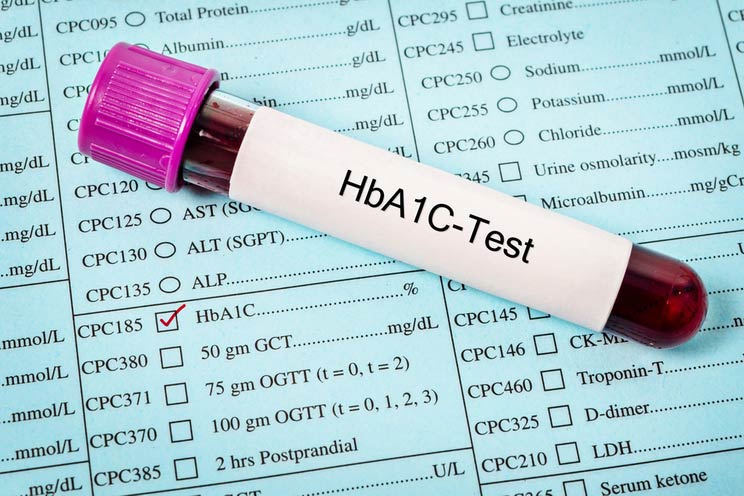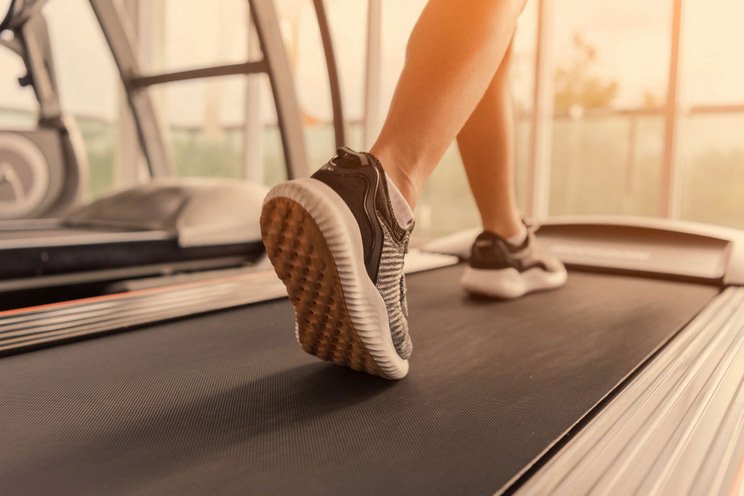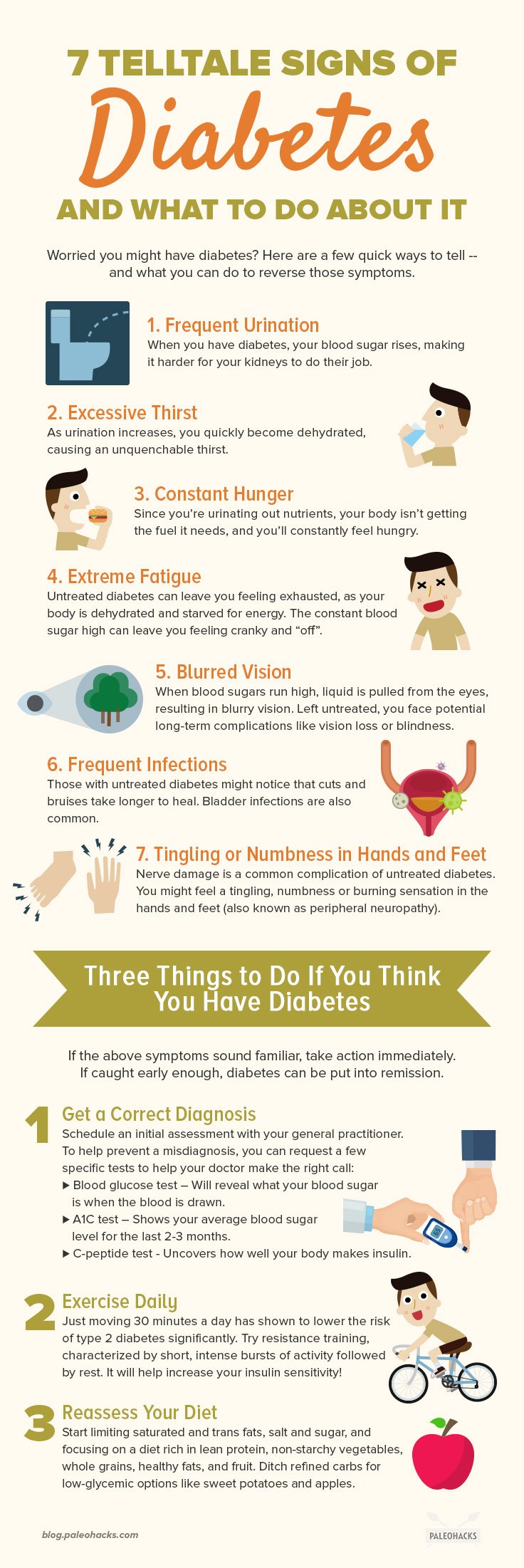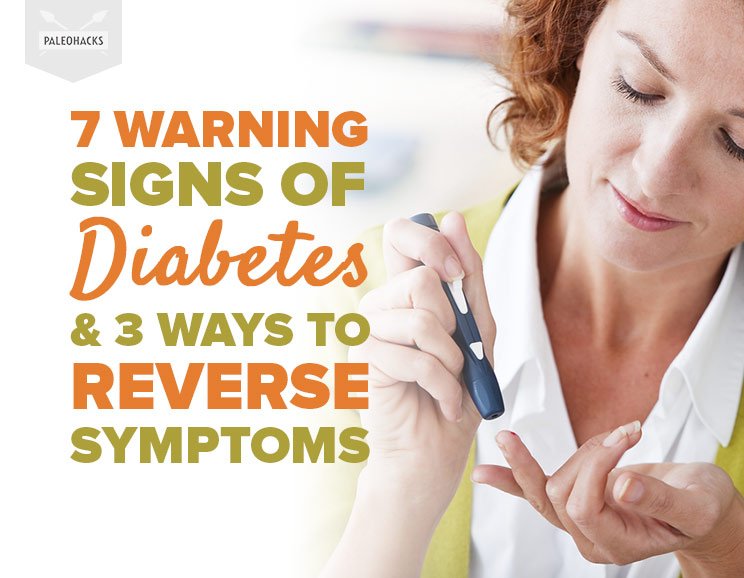Worried you might have diabetes? Here are a few quick ways to tell and what you can do to reverse those symptoms.
If you have diabetes, your pancreas either doesn’t produce enough insulin (type 1) or doesn’t use the insulin efficiently (pre-diabetes and type 2 diabetes). (1) As a result, your body can’t sufficiently move the energy you get from food out of your bloodstream and into your cells, which means that your blood sugars are higher than they should be.
Early detection and treatment are crucial for limiting the risk of long-term complications, so it’s important to be able to recognize the signs of diabetes as soon as they occur.
Suffering from Diabetes or blood sugar imbalance?
Grab our FREE Paleo & Diabetes Guide
One of the problems with identifying the symptoms of diabetes is that, in many cases, it’s synonymous with simply feeling “under the weather.” In fact, indicators can be so subtle that they often go unnoticed entirely. (2) Since symptoms can develop over several years, they can also become so normal to you that you don’t even see it as a symptom anymore, but rather a part of everyday life.
One of the most common misconceptions about diabetes is that it’s a disease that mainly affects older overweight people who eat too much sugar. The truth is that you can develop diabetes despite being young and healthy. Other factors, such as genetics, also play a significant part. Although the prevalence is higher in people older than 45, the diagnosis of type 2 diabetes among children, teens, and young adults are on the rise. (3)
7 Common Symptoms of Diabetes
There are seven common symptoms of pre-diabetes and type 2 diabetes. (4)
1. Frequent Urination
When you have diabetes, your blood sugar levels rise above normal levels. This makes your kidneys work harder to filter out the excess sugar, which your body disposes of through frequent urination. (5)
Fascinating side note: The ancient Egyptians diagnosed diabetes by seeing if ants would be attracted to the “sugary” pee of the person they suspected had diabetes. (6)
2. Excessive Thirst

If you feel like you could gulp down a large bottle of water every few minutes, it could be a sign of diabetes.
Increased thirst goes hand-in-hand with frequent urination. As your kidneys work to rid the body of the sugar in your bloodstream, you urinate more, which can make you dehydrated and cause excessive thirst. (7)
3. Constant Hunger
Since you’re peeing out a lot of the nutrition you’re taking in from food, your body isn’t getting the fuel you need, and you’ll feel hungry. You might even notice that you can eat huge amounts of food and still maintain your current weight. (8)
4. Extreme Fatigue

Untreated diabetes can leave you feeling utterly fatigued. Despite eating and drinking more, your body is both dehydrated and starved for energy. Plus, having constantly high blood sugars can leave you feeling cranky and “off.” (9)
5. Blurred Vision
When blood sugars run high, liquid is pulled from the tissues, including the eyes, which can lead to blurry vision (10), so be sure to see a doctor if you experience any occasional blurry vision. If you are diagnosed with diabetes, be aware of changes in your eyesight and get frequent eye exams. Ignoring these symptoms can lead to potential long-term complications like vision loss or blindness. (11)
6. Slowed Healing and Frequent Infections

Those with untreated diabetes might notice that cuts and bruises take longer to heal. Vaginal and bladder infections are also common, especially among women. While more research needs to be done on why exactly infections are more common, the theory is that the high levels of blood sugar impair the body’s natural healing process. (12)
7. Tingling or Numbness in Hands and Feet
Nerve damage is another common complication of untreated diabetes. The damage to the nerves is caused by elevated blood sugar levels often combined with elevated triglycerides (fat) levels in the bloodstream. (13) Damage might express itself as a tingling, numbness or burning sensation in the hands and feet in what’s known as peripheral neuropathy. (14)(15)
3 Things to Do NOW if You Think You Have Diabetes
If you’re familiar with the above symptoms and suspect you might have diabetes, take action immediately. If caught early enough, pre-diabetes can be prevented from developing into type 2 diabetes, and type 2 diabetes can still be put into remission.
1. Get a Correct Diagnosis

Schedule an appointment with your doctor so you can get tested and discuss treatment options. You don’t need to see a specialist; your general practitioner should be able to provide an initial assessment. After your diagnosis, regular visits to an endocrinologist is highly recommended.
To help prevent a misdiagnosis, you can request a few specific tests to help your doctor make the right call:
- Blood glucose test – Will reveal what your blood sugar is when the blood is drawn.
- A1C test – Shows your average blood sugar level for the last 2-3 months. (16)
- C-peptide test – Uncovers how well your body makes insulin. (17)
2. Exercise Daily

Once you know what you’re dealing with, the next step is to start exercising and, if you need to, lose some weight. Losing as little as 7% of your body weight and moving 30 minutes a day has shown to lower the risk of type 2 diabetes by a whopping 58%. (18) This guide to losing weight with diabetes can help get you started.
You should also consider adding resistance training to your weekly routine. Resistance training can increase insulin sensitivity significantly, and most people will see a reduction in glucose levels in the first few hours after exercise and up to 36 hours later. (19) (See also: How Resistance Training Affects Your Blood Sugar).
Resistance training or other types of exercise characterized by shorter intense bursts of activity followed by rest (this method is defined as anaerobic exercise) is effective at increasing your insulin sensitivity and can help to consistently lower your blood sugar. If you exercise regularly, the effect of anaerobic exercise overlaps from one workout to the next and you essentially achieve a permanent increase in insulin sensitivity. (20)
3. Reassess Your Diet

It’s a good idea to take a closer look at your diet and assess whether you need to make adjustments. There is no such thing as a special one-size-fits-all “diabetic diet” (21), but it’s recommended that people living with diabetes start limiting saturated and trans fats, salt and sugar, and focusing on a diet rich in lean protein, non-starchy vegetables, whole grains, healthy fats, and fruit.
While all types of food will affect blood sugar levels to some degree, carbohydrates will have the largest impact. That doesn’t mean that you need to cut carbohydrates from your diet. Instead, choose low to medium-glycemic carbohydrates over refined carbohydrates. Healthy carbohydrates, like sweet potatoes and apples, won’t spike your blood sugar.
The Bottom Line
Please know that being diagnosed with diabetes isn’t a death sentence. You can live a long, happy, and healthy life with diabetes, but it’s important to take it seriously and make the needed changes to prevent short-term discomfort and long-term complications.

(Read This Next: The 3 Worst Foods For Blood Sugar & 6 Healthy Foods To Eat Instead)



 13 Gentle Yoga Stretches for Neck Pain Relief
13 Gentle Yoga Stretches for Neck Pain Relief









Show Comments